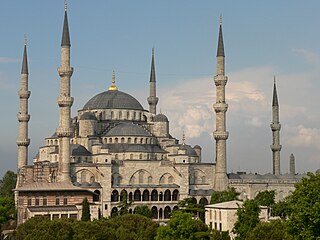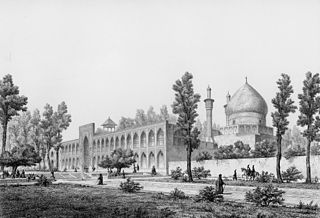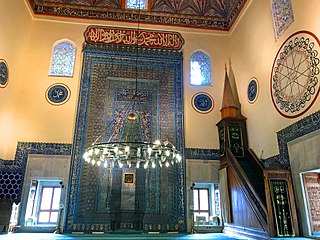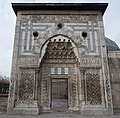
Konya, historically known as Iconium, is a major city in south-central Turkey, on the south-western edge of the Central Anatolian Plateau.

The Topkapı Palace, or the Seraglio, is a large museum in the east of the Fatih district of Istanbul in Turkey. In the 15th and 16th centuries it served as the main residence and administrative headquarters of the Ottoman sultans.

Islamic architecture comprises the architectural styles of buildings associated with Islam. It encompasses both secular and religious styles from the early history of Islam to the present day. Islamic architecture developed to fulfill Islamic religious ideals, for example, the minaret was designed to assist the muezzin in making his voice heard throughout a specific area.

Kuskovo was the summer country house and estate of the Sheremetev family. Built in the mid-18th century, it was originally situated several miles to the east of Moscow but now is part of the East District of the city. It was one of the first great summer country estates of the Russian nobility, and one of the few near Moscow still preserved. Today the estate is the home of the Russian State Museum of Ceramics, and the park is a favourite place of recreation for Muscovites.

İnce Minareli Medrese is a 13th-century madrasa located in Konya, Turkey, now housing the Museum of Stone and Wood Art, noted for its ornate entrance, domed courtyard, ornamentally bricked minaret, partially destroyed in 1901, and exemplar Anatolian Seljuk architecture.

Ottoman architecture is the architecture of the Ottoman Empire, which emerged in northwestern Anatolia in the 13th century. The architecture of the empire developed from earlier Seljuk Turkish architecture, with influences from Byzantine and Iranian architecture along with architectural traditions of the Balkans and other parts of Middle East. The classical architecture of the Ottoman Empire was a mixture of native Turkish tradition and influences from Hagia Sophia. One of the best representatives of this period is Mimar Sinan, whose major works include the Şehzade Mosque, Süleymaniye Mosque, and Selimiye Mosque.

Karatay is a town and district of Konya Province in the Central Anatolia region of Turkey. Karatay is one of the central districts of Konya along with the districts of Meram and Selçuklu. According to 2000 census, population of the district is 214,589 of which 183,677 live in the urban center of Karatay.

The Green Mosque, also known as the Mosque of Mehmed I, is a part of a larger complex on the east side of Bursa, Turkey, the former capital of the Ottoman Turks before they captured Constantinople in 1453. The complex consists of a mosque, türbe, madrasah, kitchen and bath. The name Green Mosque comes from its green and blue interior tile decorations.

Chahār BāghSchool or the Chahār BāghMadrasa, also known as Madrasa Madar-i Shah, is a 17-18th century cultural complex in Isfahan, Iran.

The Alâeddin Mosque is the principal monument on the citadel of Konya, Turkey. The building served as the "Mosque of the Throne" for the Seljuq Sultans of Rum and contains the dynastic mausoleum. It was constructed in stages between the mid-12th and mid-13th centuries. Both the citadel and the mosque bear the name of sultan 'Ala al-Din Kayqubad I.

Kubadabad Palace or Kubad Abad Palace was a complex of summer residences built for sultan Kayqubad I (1220–1237), ruler of the Sultanate of Rum. The palace is located on the southwestern shores of Lake Beyşehir in south-west Central Anatolia, Turkey, just over 100 kilometers west of the Seljuq capital at Konya.

The Mevlâna Museum, located in Konya, Turkey, is the mausoleum of Jalal ad-Din Muhammad Rumi, a Persian Sufi mystic. It was also the dervish lodge (tekke) of the Mevlevi order, better known as the whirling dervishes.

Seljuk architecture comprises the building traditions used by the Seljuk dynasty, when it ruled most of the Middle East and Anatolia during the 11th to 13th centuries. The Great Seljuk Empire contributed significantly to the architecture of Iran and surrounding regions, introducing innovations such as the symmetrical four-iwan layout and the first widespread creation of state-sponsored madrasas. Their buildings were generally constructed in brick, with decoration created using brickwork, tiles, and carved stucco.

Eşrefoğlu Mosque is a 13th-century mosque in Beyşehir, Konya Province, Turkey It is situated 100 metres (330 ft) north of the Beyşehir Lake

Aziziye Mosque or is an Ottoman mosque in Konya, Turkey.

Sırçalı Medrese is a 13th-century medrese in Konya, Turkey.

Persian domes or Iranian domes have an ancient origin and a history extending to the modern era. The use of domes in ancient Mesopotamia was carried forward through a succession of empires in the Greater Iran region.

The Madrasa of Umm al-Sultan Sha'ban is a Mamluk-era complex located in the Al-Darb al-Ahmar area of Islamic Cairo in Egypt. It was founded or built in 1368-69 CE on the order of Sultan al-Ashraf Sha'ban in honour of his mother, Khawand Baraka. It is located outside Bab Zuweila along al-Tabbana street, and is adjoined to the north by the Bayt al-Razzaz palace. The complex is made up of a college (madrasa), mausoleum, water trough (hawd), and a primary school (maktab).

Early Ottoman architecture corresponds to the period of Ottoman architecture roughly up to the 15th century. This article covers the history of Ottoman architecture up to the end of Bayezid II's reign, prior to the advent of what is generally considered "classical" Ottoman architecture in the 16th century. Early Ottoman architecture was a continuation of earlier Seljuk and Beylik architecture while also incorporating local Byzantine influences. The new styles took shape in the capital cities of Bursa and Edirne as well as in other important early Ottoman cities such as Iznik. Three main types of structures predominated in this early period: single-domed mosques, "T-plan" buildings, and multi-domed buildings. Religious buildings were often part of larger charitable complexes (külliyes) that included other structures such as madrasas, hammams, tombs, and commercial establishments.

The Iplikçi Mosque, also known as Ebülfazl Mosque, is a 13th-century Seljuk-era Islamic Friday mosque built in 1201-2 AD in the city of Konya, Turkey, to the east of Alaeddin Hill.











































